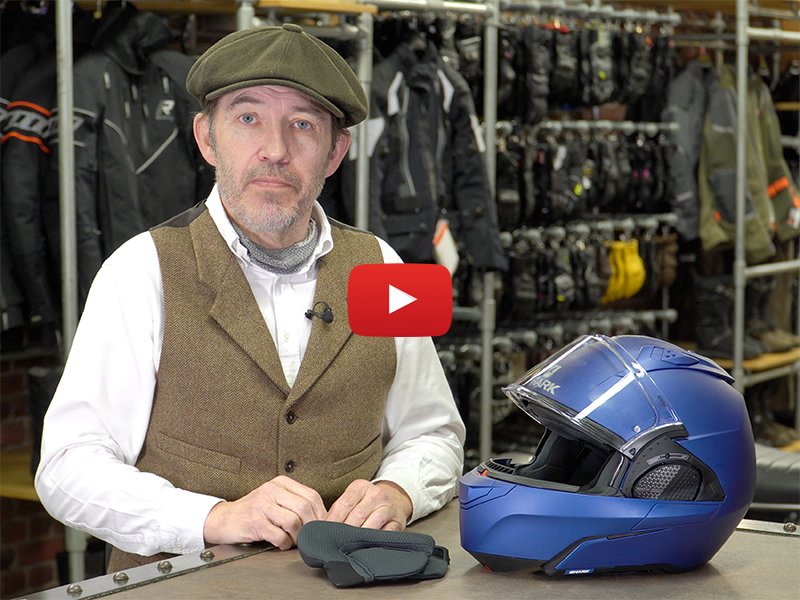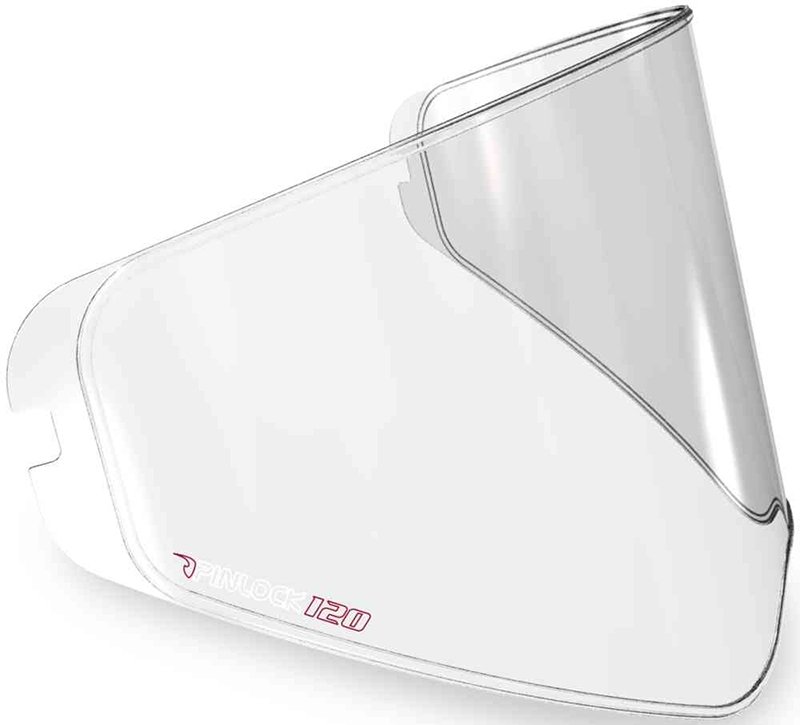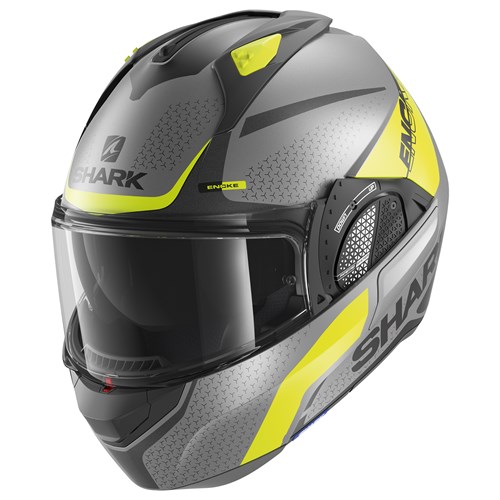Shark Evo GT helmet review
Published on: 26 April 2021

Where to start? That is the question.
This flip over helmet has now been replaced by the Shark OXO helmet, launched at the very end of 2024.
This is the latest iteration of Shark’s well-known, 180º flip-lid helmet, a series that started with the Evoline, before becoming the Evo One. The idea is a great one. It is an evolution of the standard flip-lid helmet. Whereas, on a normal flip-lid, the raised chin piece sits over the brow, thus imbuing a helmet with the aerodynamic qualities of a barn door, on the Shark Evo series, the chin piece rotates through 180º, and therefore sits at the back of the helmet, totally out of sight. The result is a helmet that works equally well as an open-face or a full-face helmet.

Roof came up with the concept first. The company is still around, and they still create some very funky-looking, flip-helmets, but on any kind of objective analysis of functionality, the Shark comes out on top. It is a better, more wearable, more serious helmet.

The Shark has evolved over the years but then, a few years ago, Shark announced a major new upgrade. Apparently, some people were not happy with the fact that, when you pulled the chin bar from its rearward position to its forward one, you had to raise the visor first. Personally, we had never come across this as an issue. We did not see it as a deal breaker. People just got used to it.

But Shark helmets made a big noise about this latest iteration, giving it a brand new name: the Evo One; the major development was that, when you brought the chin bar forward, a series of cams moved the visor up automatically and out of the way. It was clever stuff, and Shark proclaimed how this had only been made possible by using the latest ‘reverse-engineering’ techniques. Heady stuff, but there was a problem. The mechanism simply didn’t work as it was supposed to.
There were a couple of issues. The chin bar could catch as you tried to raise it. It was also difficult to close, such that Shark had to issue instructions on how to close the chin bar properly. These instructions were not well received; basically, if you have to tell motorcyclists how to close a helmet, it doesn’t work! There was another, perhaps even more significant, issue. The fine tolerances achieved, presumably by dint of ‘reverse engineering’, meant that the Pinlock visor caught on the rubber surrounding the visor aperture when you raised the chin piece. This left a mark on the Pinlock, right in the line of sight. Other than these issues, it was a fine helmet!
Shark brought out a revised version, the Evo One 2. It was better, but still not perfect. The issues were less prevalent, but did not go away completely. In particular, the Pinlock still marked. And so they brought out another new version called the Evo ES. This helmet did not come with a Pinlock, but rather with an anti-fog visor. We tested this helmet. We liked it. We have offered it ever since it came out. It has sold extremely well, and we have had no complaints about fogging and misting. Problem solved. Or so we thought.

But embarrassed by their failure, perhaps, to get the helmet to work with a Pinlock visor, Shark went back to the drawing boards; drawing boards that were now occupied by a totally new team. The company had brought in the guillotine, and heads had rolled.
So this new helmet, the new Evo GT, comes with a Pinlock. Shark tell us that it has been tested extensively, and that it now works as it always should have done. And indeed we can see that, from a number of perspectives, this is an improved helmet.
Let’s talk first about exactly what this type of helmet is, and who it is aimed at. And then we’ll go on and talk about the new upgrades.
The concept behind the Shark is attractive. The benefits and protection of a full-face helmet when you need it; but with that wind-in-your-hair feeling when you open it up. On the continent, this is a helmet that is extremely popular with those who commute into the larger cities. Outside the city, say Paris or Milan, you might ride with the chin closed, but when you approach the city centre, and the traffic causes you to slow down, you raise the chin bar to allow a bit of air in,

In our view, this is the perfect helmet for a certain kind of commute. And we say a certain kind of commute, because this a helmet that works better at speeds of, say, sixty and below. It’s not necessarily a great helmet if a large part of your commute is at motorway speeds because, frankly, it’s not the quietest helmet on the market.
But we know that a lot of people also like these helmets for touring. And we can see why. If you are travelling across Europe, and are going to be doing a mix of high-speed riding and riding through cities, this might be the perfect helmet; and especially so if you are going to end up riding somewhere really hot where an extra dose of fresh air might come in handy.
What cannot be denied is that, if you want to enjoy the benefits of an open-face and a full-face in a single package, there’s probably nothing that comes close to the Shark.
We are particular fans of the Shark, however, as an open-face; and that’s because it provides greater coverage of the chin than just about any other open-face on the market. If you do have an accident, you stand a better chance of walking away unscathed than you do with just about any other open-face helmet.
So what else do you need to know about Shark’s Evo helmets. Well, the helmet has a thermoplastic shell. That’s a pretty basic construction method these days, but thermoplastic helmets are known to do well on the SHARP test, and we have no doubt that this helmet will be accorded five stars. Not that this means much to us. The SHARP test regime is hugely flawed, and like most people in the industry, we don’t pay much attention to it. For various reasons, however, Shark does!

The helmets, like all Sharks, comes in two shell sizes. And that’s sub-optimum, in our view. To achieve the best fit, a helmet should really come in three sizes. These helmets are never the lightest. Indeed, the Evo GT in a Medium comes in at 1650 grammes. The outer visor is Optical Class 1. You also get a drop-down, sun visor. There are vents on the chin and brow. Closure is by means of a micrometric adjuster.
All the other bits are what you might expect of a good quality helmet. There’s a limited ability to change out the cheekpads to adjust the fit. The liners can also be removed for cleaning, of course.

Shark offers a comms. system called Sharktooth, but the general consensus is that it should be avoided at all costs. Our recommendation would be the brand new Interphone UCOM. It’s a lovely, super-thin unit, and it is totally compatible with Sena, as well as with Interphone.
So what is new on the Shark Evo GT?
The most obvious visual change is the metal guides on the side of the chin bars, into which the chin bar locks and fastens. It works much better than the old system. We haven’t had the new helmet in our hands for long, but we’ve opened and closed it more than most people would in a year’s useage, and it works. It did not fail once.

Shark suggest that you can close the chin bar one-handed and in one movement. Well, perhaps once you’ve developed a knack, but we couldn’t do it one handed and get it to lock on both sides. As with any flip-lid, we reckon you close it on one side, and then double-check that it’s located on the other. No problem with that. Even if you could securely close the helmet with one hand, you’d still always want to check the other side.

The other major upgrade for the Evo GT is not just that it comes with a Pinlock, which it does; but that it comes with a top-of-the-range Pinlock 120. The very best Pinlock you can get. And this, we are informed, comes as a result of a previous Shark helmet that we reviewed on Youtube. In essence, we criticised Shark for fitting a lower grade Pinlock on one of their helmets. It was about then that we stopped receiving Christmas cards from the french company, but the good news is that Shark will now fit Pinlock 120s on all its new helmets. However this development came about, it is a welcome upgrade. What we can also report is that the insert doesn’t seem to rub on the lip of the visor aperture any more. So they seem to have solved that problem as well. Fingers crossed.

There’s a third upgrade on the new Evo ES. And it’s to do with the way the helmet fits and wears. Because of the shape of the Evo helmet and the way the mechanism operates, the helmet fits very tightly on the cheeks. Not just on this helmet, but on all Evo helmets. It often gives the wearer quite a pronounced set of ‘chipmunk cheeks’. That’s kind of how it’s meant to fit. But some people don’t like the feeling. The other issue is that, if you have what could be called a ‘fuller’ face, you can find yourself putting so much pressure on the flexible sides of the helmet that the chin bar won’t lock into place. For both of these groups of riders, the good news is that the helmet now comes with a thinner set of cheekpads in the box.
So that’s the upgrades. A better closure mechanism. A better Pinlock. And a better arrangement that means that the insert won’t scratch. Finally, a set of thinner cheekpads.
We have been very happy with the Evo ES ever since it was launched a year or so ago; and we weren’t necessarily gagging for an upgraded model. After all, it’s the first Evo helmet for a number years that we haven’t had any issues with.
The new closure mechanism is welcome, although as it constitutes the correcting of something that didn’t work, then it barely qualifies as an upgrade in our book; more a fix; although it is undoubtedly an improvement. The new Pinlock is welcome, but for most people there wasn’t a fogging problem on the ES, so it potentially offers a solution to a problem that, for most, didn’t exist.
The only people, as we see it, for whom the helmet represents a significant upgrade are those who commute in the current ES throughout the winter. There is a possibility that the people who do this might experience a certain amount of fogging in cold and wet conditions, although we have not heard from any customers that this has been a problem. With a Pinlock 120, there should never be any fogging. But the fact is that an Evo helmet is, perhaps, not the kind of helmet that long-distance commuters riding through the winter would choose. It is, for one, a tad noisy. But if you commute all through the year, then the Evo GT might well be worth the extra money.
The extra cheekpads are a nice touch but, in our view, should only be fitted if it proves impossible to fasten the helmet. And that’s because the helmet is actually meant to put quite a severe squeeze on the cheeks.
The new helmet, in a plain colour, costs £80 more than the current ES. If you are buying into the concept for the first time, you might feel that you want to go for the latest iteration. Cost aside, there is probably no reason not to. But if you have an ES, and are happy with it, we would say don’t change it. If, however, you have an ES, and you do experience fogging and misting, you might want to consider the new model.
At times, less is more. The current ES helmet offers less, in some ways, and because of that, perhaps, it has proven to be more reliable. It works well, and we have had no customers unhappy with the way it works. We don’t anticipate any problems with the Evo GT, but we still take the view that, for many, the ES will be more than up to the job.
You can see all the different Shark helmets we stock here.
Share this story












































































